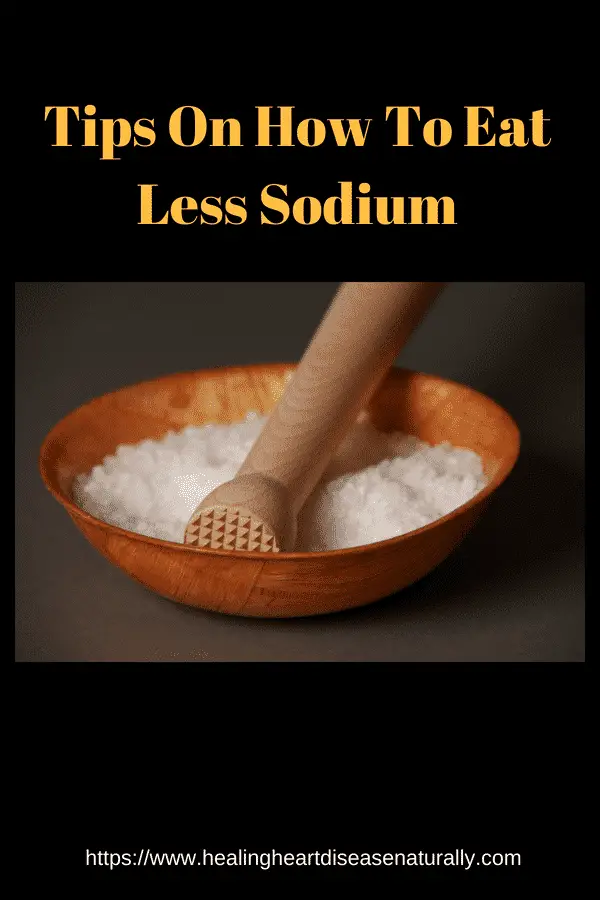Nine out of 10 Americans eat more sodium (salt) than they need. Too much sodium increases your risk for health problems like high blood pressure.
To eat less sodium, you don’t have to make lots of changes at once. If you cut back on sodium little by little, your taste for salt will change with time.
Use these tips to help lower the amount of sodium in your diet.
Tips on How to Eat Less Salt or Sodium 
Ask your doctor how much sodium is okay for you. The general guidance is:
- Healthy adults and teens age 14 and older need to limit their sodium intake to no more than 2,300 mg a day (about 1 teaspoon of salt).
- Some adults, including people with high blood pressure, need to limit their sodium intake to 1,500 mg a day.
- Children need no more than 1,500 to 2,200 mg a day of sodium, depending on how old they are.
Check the label.
- Use the Nutrition Facts label to check the amount of sodium in foods. Try to choose products with 5% Daily Value (DV) or less. A sodium content of 20% DV or more is high.
- Look for foods labeled “low sodium,” “reduced sodium,” or “no salt added.”
Shop for low sodium foods.
- Load up on vegetables, fruits, beans, and peas, which are naturally low in sodium. Fresh, frozen, and dried options are all good choices.
- When you buy canned foods (like vegetables, beans, or fish), choose ones with labels that say “low sodium,” “reduced sodium,” or “no salt added.”
- Compare the sodium in prepared foods like bread, soup, and frozen meals. Choose the ones with less sodium.
- Limit processed meats – especially ones that are salted, smoked, or cured, like hot dogs, bacon, and deli meats.
Prepare your meals with less sodium.
- If you use canned foods that aren’t low in sodium, rinse them before eating or cooking with them. This will wash away some of the salt.
- Use unsalted margarine or spreads with no trans fats.
- Don’t add salt to the water when you cook pasta or rice.
- Try different herbs and spices to flavor your food, like ginger or garlic, instead of salt.
- Take the salt shaker off your table.
Get Low salt when you eat out.
- When you order at a restaurant, ask that salt not be added to your food.
- Choose low-sodium options when you can – like dishes that are steamed, broiled, or grilled.
Tips on How to Eat Low Sodium:
Add more potassium to your diet
Replace high-sodium foods with high-potassium foods. Eating foods with potassium can help lower your blood pressure. Good sources of potassium include potatoes, cantaloupe, bananas, beans, milk, and yogurt.
Other Tips to Decrease the Sodium
- Buy fresh, frozen, or no-salt-added canned vegetables. Choose food packed in water instead of broth or salt.
- Buy fresh garlic or garlic powder instead of garlic salt.
- Choose foods labeled “low sodium,” “sodium-free,” or “no-salt-added.”
- Eat fresh vegetables and fruit instead of salty snacks.
- Slowly cut back on the amount of salt added when cooking until you don’t use any.
- Do not add salt to the water when cooking beans, rice, pasta, and vegetables.
- Cut back on meats high in sodium, such as bologna, ham, hot dogs, and sausage.
- Rinse all canned products to reduce the amount of sodium.
- Use reduced-sodium bouillon and soy sauce. If you use these condiments, do not
add salt to your food.
These are tips on how to decrease salt or sodium. According to the World Medical Association
Dietary table salt is an ionic compound comprising of sodium chloride, which is 40% sodium (Na+) and 60% chloride (Cl-). There is overwhelming evidence that excessive sodium intake is a risk factor for the development, or worsening of hypertension, which is one of the main cardiovascular risk factors. Hypertension may also be an independent risk factor for cardiovascular diseases as well as all-cause mortality. The effect of dietary sodium on blood pressure is influenced by various demographic factors such as age and ethnicity. World Medical Association
Reference:



This is a nice, concise article with informative facts and useful tips. I am a fan of some fruit yogurt which is a good source of potassium as you mentioned, but I don’t think I could use unsalted butter even if I attempted to gradually infuse it into my regular meals.
Thank you, Phyllis! Very helpful!
Why thank you!! I am glad you enjoyed it
Nurse Phyllis